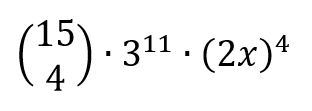I have an example worked through, but i do not know how a number is being calculated...
Calculating a specific coefficient or term
The formula is particularly effective when you have to calculate a specific coefficient or term in an expansion
For example you may be asked to calculate e.g. the coefficient of x4 in (3+2x)15.
Pascal's Triangle would clearly be an inefficient way of doing this as you would have to calculate all the rows down to the fifteenth.
Expanding the whole expression would also be inefficient. We only need the x4 term so why would we calculate all of the 14 other terms too?
The term that contains the x4 is calculated by

So the term containing x4 is 1365×177147×16x4=3868890480x4
Where does the 1365 come from?
Please could someone show me the steps to calculating it?
Calculating a specific coefficient or term
The formula is particularly effective when you have to calculate a specific coefficient or term in an expansion
For example you may be asked to calculate e.g. the coefficient of x4 in (3+2x)15.
Pascal's Triangle would clearly be an inefficient way of doing this as you would have to calculate all the rows down to the fifteenth.
Expanding the whole expression would also be inefficient. We only need the x4 term so why would we calculate all of the 14 other terms too?
The term that contains the x4 is calculated by

So the term containing x4 is 1365×177147×16x4=3868890480x4
Where does the 1365 come from?
Please could someone show me the steps to calculating it?
